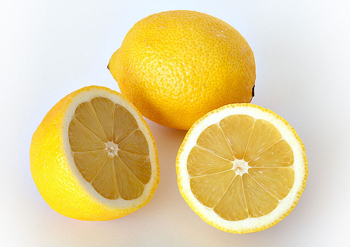Contents:
Common Names | Parts Usually Used | Plant(s) & Culture | Medicinal Properties | Biochemical Information
Legends, Myths and Stories | Uses | Formulas or Dosages | Nutrient Content | How Sold | Warning | Bibliography
Scientific Names

- Citrus limon L.
Common Names
- Lemon tree
Parts Usually Used
Fruit
Back to Top

Description of Plant(s) and Culture
Lemons grow on trees, particularly in California and Florida.
Back to Top
Medicinal Properties
Antihistaminic, anti-inflammatory, astringent, diuretic, refrigerant, tonic
Back to Top
Biochemical Information
Rich in vitamin C
Back to Top

Legends, Myths and Stories
Used as Vermouth flavorings; oil and fresh peel used in liqueurs and aperitifs; and is a lemon hair rinse for blondes. Gives blond highlights. Use the strained juice of 2 lemons in an equal amount of warm water. Leave on 15 minutes and sit in the sun if possible. Then rinse out. The juices of lemons and other citrus fruits are often added to cosmetic preparations because of their astringent and acidic qualities.
Back to Top

Uses
Lemon juice is a popular home remedy for numerous ailments, particularly colds, coughs, asthma, sore throats, diphtheria, influenza, heart burn, liver complaints, fevers. It is sometimes taken for headaches, nourishes the brain and nerve cells, neuralgia, scurvy, blood purifier, malaria, rickets, tuberculosis, gout, and chronic rheumatism. Externally, lemon juice can be used on sunburn, warts, felons, and corns. It is currently enjoying a revival of interest in hair rinse and facial astringent. Lemon’s vitamin C and astringency also make lemon powder useful to stop bleeding in wounds.
Always take lemon juice without sweetening.
Good for household uses; lemon juice will sour sweet milk, making it suitable for cooking. Just add a few drops or a small tsp. to each cup of milk. (This will curd soybean milk)
Use lemon juice in place of vinegar, also all a little juice to dried fruits, this adds to the flavor. Add while stewing the fruit.
Remove vegetable stains from hands by rubbing with lemon juice. Keeps hands soft and removes odors such as onions.
To remove ink stains, iron rust, or fruit stains, rub the stain well with lemon juice, cover with salt, and put in the sun. Repeat if necessary.
Back to Top
Formulas or Dosages
Take lemon juice straight or diluted with water, preferably unsweetened. For coughs and colds, add honey (and some liquor, if you are inclined that way). For a cold, take a hot bath and go to bed. Before falling asleep, have a cup of hot lemon juice (1 lemon) and water in which you have dissolved 1 tbsp. of honey and 2 tbsp. of liquor. You’ll wake the next morning with your cold gone–or at least considerably better. For persistent coughing, take a tsp. of honey with fresh lemon juice squeezed over it. Hold in the mouth and swallow slowly. Unlike drug cough medicines, you can use this as frequently as you like. The juice of a lemon mixed with a pint of warm water can be used as a retention enema for acute hemorrhoids; retain for 5 minutes. Lemon juice in hot water is said to relieve stomach distress and dizziness. The juice of a lemon in a glass of warm water upon arising is a good habit to promote regularity.
Back to Top
Nutrient Content
Magnesium, calcium, potassium, vitamin C

How Sold
Found in the produce department of the supermarket.
Back to Top
Warning
Ensure essential oil is well diluted before use; it can irritate the skin.
Back to Top
Bibliography
![]() The Complete Medicinal Herbal
The Complete Medicinal Herbal, by Penelope Ody, Dorling Kindersley, Inc, 232 Madison Avenue, New York, NY 10016, First American Edition, copyright 1993
![]() Back to Eden
Back to Eden, by Jethro Kloss; Back to Eden Publishing Co., Loma Linda, CA 92354, Original copyright 1939, revised edition 1994
![]() Indian Herbalogy of North America
Indian Herbalogy of North America, by Alma R. Hutchens, Shambala Publications, Inc., Horticultural Hall, 300 Massachusetts Avenue, Boston, Massachusetts 02115, 1973
![]() The Herbalist Almanac
The Herbalist Almanac, by Clarence Meyer, Meyerbooks, publisher, PO Box 427, Glenwood, Illinois 60425, copyright 1988, fifth printing, 1994
![]() The Herb Book
The Herb Book, by John Lust, Bantam Books, 666 Fifth Avenue, New York, NY. copyright 1974.
![]() The Nature Doctor: A Manual of Traditional and Complementary Medicine
The Nature Doctor: A Manual of Traditional and Complementary Medicine, by Dr. H.C.A. Vogel; Keats Publishing, Inc., 27 Pine Street (Box 876) New Canaan, CT. 06840-0876. Copyright Verlag A. Vogel, Teufen (AR) Switzerland 1952, 1991
 Old Ways Rediscovered
Old Ways Rediscovered, by Clarence Meyer, Meyerbooks, publisher, PO Box 427, Glenwood, Illinois 60425, published from 1954, print 1988
![]() Planetary Herbology
Planetary Herbology, by Michael Tierra, C.A., N.D., O.M.D., Lotus Press, PO Box 325, Twin Lakes. WI 53181., Copyright 1988, published 1992
![]() Webster’s New World Dictionary
Webster’s New World Dictionary, Third College Edition, Victoria Neufeldt, Editor in Chief, New World Dictionaries: A Division of Simon & Schuster, Inc., 15 Columbus Circle, New York, NY 10023
![]() The Yoga of Herbs: An Ayurvedic Guide to Herbal Medicine
The Yoga of Herbs: An Ayurvedic Guide to Herbal Medicine, by Dr. David Frawley & Dr. Vasant Lad, Lotus Press, Twin Lakes, Wisconsin, Second edition, 1988.
 The Rodale Herb Book: How to Use, Grow, and Buy Nature’s Miracle Plants (An Organic gardening and farming book)
The Rodale Herb Book: How to Use, Grow, and Buy Nature’s Miracle Plants (An Organic gardening and farming book), edited by William H. Hylton, Rodale Press, Inc. Emmaus, PA, 18049., 1974
